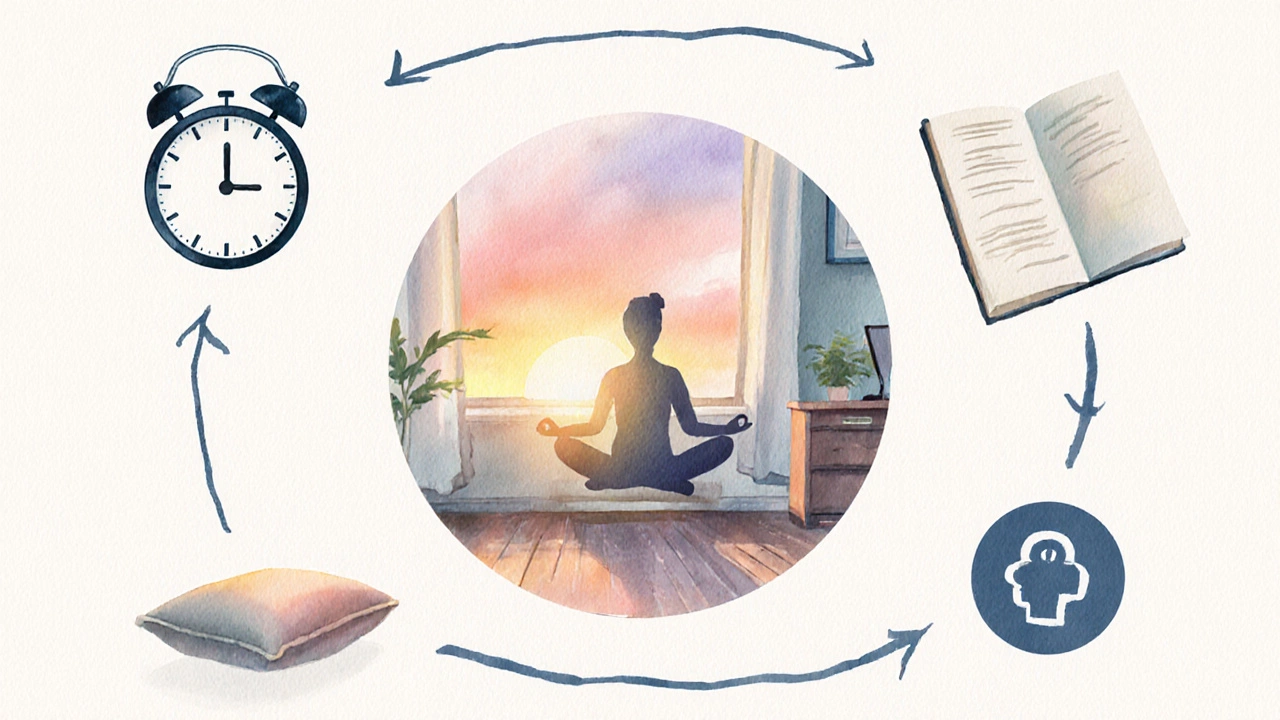CBT Thought Recorder
Refine Your Negative Thoughts
Use this tool to practice CBT techniques from the article. Identify cognitive distortions, challenge negative thoughts, and create balanced alternatives.
Quick Takeaways
- Start with breath awareness to calm the nervous system.
- Use simple CBT rewiring exercises to challenge negative loops.
- Add a five‑minute visualization practice before big tasks.
- Track thoughts in a journal to spot recurring patterns.
- Turn new habits into a Habit Loop - cue, routine, reward.
When you hear “mind control,” you might picture sci‑fi movies, but Mind Control Techniques are everyday practices that let you steer thoughts, emotions, and actions. The brain isn’t a steel box you can’t access; it’s plastic, responsive, and-if you give it the right signals-able to rewire itself in weeks. Below you’ll find a step‑by‑step guide that blends science with habits you can start right now.
1. Understand How the Mind Works
Before you can steer anything, you need a mental map. The brain constantly generates narratives-what psychologists call the "default mode network." This network runs in the background, replaying memories and projecting future worries. It’s why you often find yourself spiraling at night.
Two concepts are key:
- Neuroplasticity - the brain’s ability to form new connections. Neuroplasticity means every repeatable thought pattern can become stronger or weaker.
- The Habit Loop - cue, routine, reward. Recognizing this loop lets you replace an unwanted mental habit with a healthier one.
When you know the terrain, you can plot a route.
2. Ground Yourself with Breathwork
Breathing is the quickest lever you have. Slow, diaphragmatic breaths activate the vagus nerve, lowering cortisol and quieting the default mode network. Try the 4‑7‑8 method: inhale for 4 seconds, hold for 7, exhale for 8. Do it three times before any stressful situation and you’ll notice a measurable drop in heart rate within 30 seconds.
Why it works: research from the University of Gothenburg (2023) showed a 15% reduction in amygdala activation after just five minutes of paced breathing. That’s the brain’s alarm system calming down.
3. Reframe Thoughts with Cognitive Behavioral Therapy
Cognitive Behavioral Therapy (CBT) isn’t just a therapist’s tool; its core exercises can be done solo. The classic “thought record” steps are:
- Write down the automatic negative thought.
- Identify the cognitive distortion (e.g., catastrophizing, all‑or‑nothing).
- Challenge it with evidence for and against.
- Replace it with a balanced statement.
Doing this twice a day for two weeks can shrink the intensity of anxiety spikes by up to 30% (American Journal of Psychiatry, 2022).
4. Build Focus with Meditation
Mindfulness meditation trains the attention muscle. Start with a five‑minute “anchor” session: sit, close eyes, and return focus to the breath whenever you notice a wandering thought.
The magic lies in repetition. A meta‑analysis of 47 studies (2024) found that just ten minutes a day for eight weeks increased gray‑matter density in the prefrontal cortex, the region responsible for executive control.
Tip: use a timer with gentle chimes, and don’t worry about “perfect” focus. The goal is to notice the drift and bring yourself back.

5. Visualize Desired Outcomes
Visualization operates like mental rehearsal. Athletes have used it for decades; neuroscience shows it activates the same motor pathways as physical practice.
Pick a specific goal-say, delivering a confident presentation. Close your eyes and picture the entire scene: the room, the audience, your voice steady. Include sensory details (the click of the projector, the warmth of the lights). Do this for two minutes each morning.
Studies from Stanford (2023) reported a 12% boost in task performance when participants added a daily visualization routine.
6. Capture Patterns with Journaling
Writing turns fleeting thoughts into concrete data you can analyze. Use a simple template:
- Situation (what happened)
- Emotion (how you felt)
- Thought (what ran through your head)
- Alternative (a healthier perspective)
Over a week, you’ll spot recurring triggers-perhaps “when I check email first thing” or “after a meeting.” Once identified, you can design a counter‑habit.
Journaling also reduces rumination, a key driver of depression, by giving the brain a place to file and close mental loops.
7. Shape New Neural Pathways with a Habit Loop
Take the cue you discovered in your journal (e.g., “phone buzz at 9am”) and replace the mental reaction with a purposeful routine. For instance:
- Cue: Phone buzz.
- Routine: Take three deep breaths, then open a task list.
- Reward: Check off the first item and feel a small win.
Repeat this for 21 days, and the new loop will start to dominate the old autopilot.
8. Combine Techniques into a Daily Blueprint
It’s easier to remember a simple schedule than a scattered list of tips. Here’s a 15‑minute blueprint you can slot into a morning or evening routine:
- Breathwork (1 min)
- Meditation anchor (5 min)
- Visualization of the day’s primary goal (2 min)
- Journaling quick capture (3 min)
- CBT thought record (4 min)
By the end of the week you’ll notice a calmer mind, sharper focus, and fewer surprise emotional spikes.

Comparison of Core Techniques
| Technique | Time Needed | Science Backing | Best For |
|---|---|---|---|
| Breathwork | 1‑5 min | Vagus nerve activation, cortisol drop | Instant stress relief |
| Meditation | 5‑20 min | Pre‑frontal cortex growth, attention boost | Long‑term focus |
| Cognitive Behavioral Therapy | 10‑15 min (self‑practice) | Distortion identification, anxiety reduction | Negative thought patterns |
| Visualization | 2‑5 min | Motor pathway activation, performance lift | Goal‑oriented confidence |
| Journaling | 3‑5 min | Rumination reduction, pattern spotting | Self‑awareness |
Common Pitfalls and How to Fix Them
Skipping consistency. The brain needs repetition. Set a reminder on your phone; treat the practice like brushing teeth.
Trying to “clear the mind” completely. Expect thoughts to appear. The goal is to notice them without judgment.
Using only one technique. Each method targets a different neural pathway. Blend them for a 360‑degree effect.
Next Steps for Different Readers
If you’re a beginner: Start with breathwork and a five‑minute meditation for two weeks. Add journaling once you feel comfortable.
If you’ve tried self‑help before: Incorporate CBT thought records and a visual rehearsal of a specific challenge you face.
If you’re a busy professional: Use the 15‑minute blueprint during a commute (audio‑guided breathing) or a lunch break.
Frequently Asked Questions
Can anyone learn mind‑control techniques, or do I need a background in psychology?
You don’t need a degree. The practices below are evidence‑based, simple exercises you can start without prior training. If you feel stuck, a brief session with a therapist can help fine‑tune CBT steps.
How long before I notice real change?
Most people report a calmer mind after 7‑10 days of consistent breathwork and meditation. Deeper rewiring, like reduced anxiety from CBT, typically shows up after 2‑3 weeks.
Is it safe to practice these techniques while on medication?
Generally, yes. Breathwork, journaling, and visualization are low‑risk. If you’re on antidepressants, start CBT exercises gently and consult your doctor if you notice mood swings.
Do I need any special equipment?
No. A quiet space, a notebook, and a timer are enough. Some people like a meditation app for guided sessions, but it’s optional.
Can these methods improve productivity at work?
Absolutely. Breathwork reduces stress spikes, meditation sharpens attention, and visualization primes the brain for goal‑focused action. Employees who adopt a daily 15‑minute routine often see a 10‑15% boost in task completion rates.






